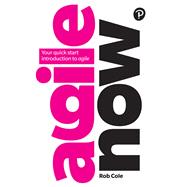Want to work smarter, faster and more productively?
Agile is an innovative way of working that will help you deliver high quality products and services cost-effectively, to embrace change and keep improving as you go. Whether you’re a one-person start-up or with a multinational, Agile Now will help you get to grips with the essence of agile thinking, identify what works best, avoid common mistakes and boost your efficiency.
Agile Now is a quick-start introduction with universal appeal, bringing together all the essential theory with practical advice, so you harness the power of agile and hit the ground running.
Join the agile revolution. Get agile, now.








